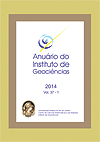Physics features of mesoscale convective systems that reached Rio Grande do Sul state in 2006
DOI:
https://doi.org/10.11137/2014_1_70_80Abstract
It was studied the seasonal physics features of the Mesoscale Convective Systems that reached Rio Grande do Sul (RS) State (MCS RS) in 2006, using ForTrACC tool (Forecasting and Tracking of Active Cloud Clusters). Channel 4 GOES-12 (Geostationary Operational Environmental Satellite) images from 2006 year, with 4 km x 4 km spatial resolution in the subsatellite point and ½ hour temporal resolution were used. These images were provided by DSA/CPTEC/INPE (Divisão de Satélites e Sistemas Ambientais do Centro de Previsão de Tempo e Estudos Climáticos do Instituto Nacional de Pesquisas Espaciais) and were the data basis to the ForTrACC tool. The results showed that: i) most MCS RS occurred in the warmest quarters and showed lifetime between 6 and 12h, ii) MCS RS with higher lifetime covered larger areas, iii) the largest and most long MCS RS were observed in JAS (Jul, Aug, Sep); iv) MCS RS presented the three phases of their life cycle distributed throughout the day; v) MCS RS had preferential initiation over the continent, and vi) MCS RS presented mean preferential trajectory from west to east.Downloads
Download data is not yet available.
Downloads
Published
2014-06-01
How to Cite
Eichholz, C. W. and Campos, C. R. J. de (2014) “Physics features of mesoscale convective systems that reached Rio Grande do Sul state in 2006”, Anuário do Instituto de Geociências. Rio de Janeiro, BR, 37(1), pp. 70–80. doi: 10.11137/2014_1_70_80.
Issue
Section
não definida
License
This journal is licensed under a Creative Commons — Attribution 4.0 International — CC BY 4.0, which permits use, distribution and reproduction in any medium, provided the original work is properly cited.















